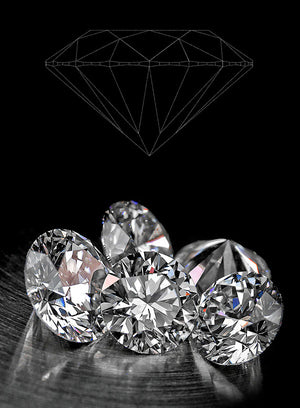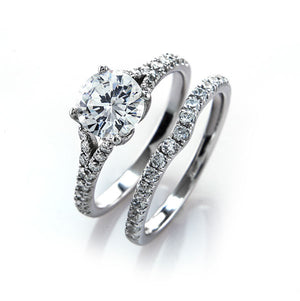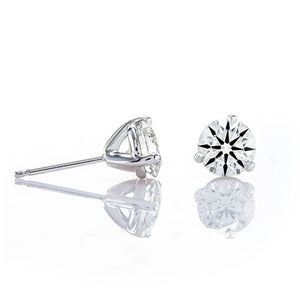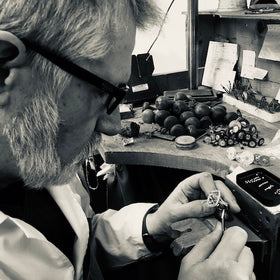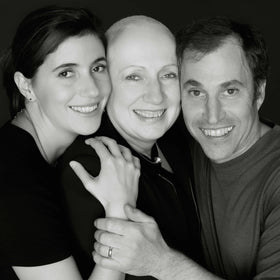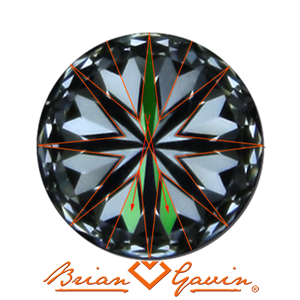
Hearts & Arrows: Brian Gavin is the only online retailer with the largest in-house inventory of true H&A diamonds
We know that it’s a bold statement, but it’s also true. “Brian Gavin has the largest in-house inventory of genuine hearts and arrows diamonds.”
Which stands to reason when you know what to look for. And once you do, you’ll be able to see the differences in the patterns exhibited by hearts and arrows diamonds cut to different degrees of optical precision.
The fact of the matter is that most “hearts and arrows diamonds” are literally not cut to the higher standards of Brian Gavin. From that perspective, they can’t be true hearts and arrows diamonds.
The sad truth is that the majority of hearts and arrows diamonds are a slight improvement over their standard ideal counterparts. It’s true that they exhibit some sort of hearts and arrows pattern, but those patterns frequently show inconsistencies in which lower levels of optical precision are evident.
Here are some examples of H&A diamonds that don’t make the cut:

“They” might call these hearts and arrows diamonds, but these diamonds do not meet Brian Gavin’s selection standards because the hearts patterns are inconsistent and lack uniformity.
Variations in the size, shape, and spacing of hearts patterns and/or twisting at the tips of the hearts are the result of differences in the length of the lower girdle facets and/or the alignment of the facets from the perspective of three hundred and sixty degrees.
It’s as simple as that.
And here’s another simple truth. Just because a round brilliant cut diamond exhibits a pattern of hearts and arrows, does not mean that’s a hearts and arrows diamond in the truest sense.
Why not? Because the reality is that all round brilliant cut diamonds have the potential to exhibit some sort of hearts and arrows pattern.
 The hearts pattern is created by light reflecting off the pavilion main facets as shown here in the 12 o’clock position. Then it reflects across the diamond, as pictured here in the direction of six o’clock. Then the light splits apart across the pavilion main facets on the other side of the diamond and reflects off of the lower girdle facets on the left and right side of the pavilion main facet.
The hearts pattern is created by light reflecting off the pavilion main facets as shown here in the 12 o’clock position. Then it reflects across the diamond, as pictured here in the direction of six o’clock. Then the light splits apart across the pavilion main facets on the other side of the diamond and reflects off of the lower girdle facets on the left and right side of the pavilion main facet.
This is all pretty amazing when you stop to think about it. And since every standard round brilliant cut diamond has the same facet structure, they all have the potential.
But what separates true hearts and arrows diamonds apart from the rest is the skill of the diamond cutter. It requires a great deal of skill and high-end diamond cutting equipment to align the facets and polish them to the degree of precision required to control the pattern of light reflecting throughout the diamond. The slightest variance in facet alignment, length, or shape, can have dramatic effects upon the consistency of light return.
And it shows, not only in the precision of the hearts pattern, but also in the way that light reflects throughout the diamond. For this reason, you’ll see a clear difference when you compare hearts and arrows diamonds produced under the watchful eye of Brian Gavin compared with all the rest.

The Brian Gavin Difference:
You’ll be able to see a distinct difference in the pattern of light return and you’ll also see differences in the degree of light performance and sparkle factor. Black by Brian Gavin and Brian Gavin Signature H&A diamonds exhibit a higher volume of light return and deliver sparkle factor that is more vivid and intense.
It’s an appreciable difference that you’ll grow to appreciate the more you know about diamonds. Which is why connoisseurs of genuine hearts and arrows diamonds choose Brian Gavin over the competition.
It’s a difference in sparkle factor.
It’s a difference in light performance.
It’s a difference in the volume of light return.
It’s a difference in the intensity of the sparkle.
It’s a difference in how light reflects.
It’s a difference that you can see and appreciate.
Which is why more and more people like you choose Brian Gavin time and time again.





